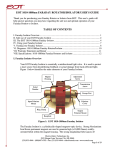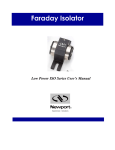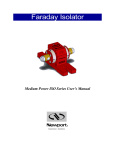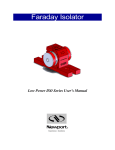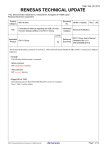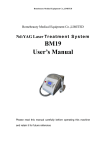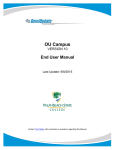Download Faraday Isolator - Newport Corporation
Transcript
Faraday Isolator 1030-1080nm ISO-FRDY-OPT Series User’s Manual ii Preface Warranty Newport Corporation warrants that this product will be free from defects in material and workmanship and will comply with Newport’s published specifications at the time of sale for a period of one year from date of shipment. If found to be defective during the warranty period, the product will either be repaired or replaced at Newport's option. To exercise this warranty, write or call your local Newport office or representative, or contact Newport headquarters in Irvine, California. You will be given prompt assistance and return instructions. Send the product, freight prepaid, to the indicated service facility. Repairs will be made and the instrument returned freight prepaid. Repaired products are warranted for the remainder of the original warranty period or 90 days, whichever is longer. Limitation of Warranty The above warranties do not apply to products which have been repaired or modified without Newport’s written approval, or products subjected to unusual physical, thermal or electrical stress, improper installation, misuse, abuse, accident or negligence in use, storage, transportation or handling. This warranty also does not apply to fuses, batteries, or damage from battery leakage. THIS WARRANTY IS IN LIEU OF ALL OTHER WARRANTIES, EXPRESSED OR IMPLIED, INCLUDING ANY IMPLIED WARRANTY OF MERCHANTABILITY OR FITNESS FOR A PARTICULAR USE. NEWPORT CORPORATION SHALL NOT BE LIABLE FOR ANY INDIRECT, SPECIAL, OR CONSEQUENTIAL DAMAGES RESULTING FROM THE PURCHASE OR USE OF ITS PRODUCTS. First printing 2005 © 2005 by Newport Corporation, Irvine, CA. All rights reserved. No part of this manual may be reproduced or copied without the prior written approval of Newport Corporation. This manual has been provided for information only and product specifications are subject to change without notice. Any change will be reflected in future printings. Newport Corporation 1791 Deere Avenue Irvine, CA, 92606 USA P/N 44759-01 Rev. A Preface iii Technical Support Contacts North America & Asia Europe Newport Corporation Service Dept. Newport/MICRO-CONTROLE S.A. 1791 Deere Ave. Irvine, CA 92606 Zone Industrielle Telephone: (949) 253-1694 45340 Beaune la Rolande, FRANCE Telephone: (800) 222-6440 x31694 Telephone: (33) 02 38 40 51 56 Asia Newport Opto-Electronics Technologies 253 Aidu Road, Bld #3, Flr 3, Sec C, Shanghai 200131, China Telephone: +86-21-5046 2300 Fax: +86-21-5046 2323 Newport Corporation Calling Procedure If there are any defects in material or workmanship or a failure to meet specifications, promptly notify Newport's Returns Department by calling 1-800-222-6440 or by visiting our website at www.newport.com/returns within the warranty period to obtain a Return Material Authorization Number (RMA#). Return the product to Newport Corporation, freight prepaid, clearly marked with the RMA# and we will either repair or replace it at our discretion. Newport is not responsible for damage occurring in transit and is not obligated to accept products returned without an RMA#. E-mail: [email protected] When calling Newport Corporation, please provide the customer care representative with the following information: • • • Your Contact Information Serial number or original order number Description of problem (i.e., hardware or software) To help our Technical Support Representatives diagnose your problem, please note the following conditions: • • • • • Is the system used for manufacturing or research and development? What was the state of the system right before the problem? Have you seen this problem before? If so, how often? Can the system continue to operate with this problem? Or is the system nonoperational? Can you identify anything that was different before this problem occurred? iv Preface Table of Contents Warranty................................................................................................. ii Technical Support Contacts .................................................................. iii Table of Contents .................................................................................. iv 1 General Information 1.1 1.2 1.3 1.4 Introduction ...................................................................................1 Safety.............................................................................................2 Operation .......................................................................................4 1.3.1 Using your Faraday Isolator ..............................................7 1.3.2 Tuning your Faraday Isolator ............................................9 Specifications ..............................................................................11 2 Factory Service Information 2.1 1 13 Service Form ...............................................................................13 1 General Information 1.1 Introduction Your Newport Faraday Isolator is essentially a uni-directional light valve. It is used to protect a laser source from destabilizing feedback or actual damage from back-reflected light. Figure 1 below identifies the main elements of your Faraday Isolator. Figure 1: Newport’s High Power 1030 – 1080nm Faraday Isolator Magnet Housing Transmission Arrow Escape Port Polarizer Cover Input Polarizer Output Polarizer Base The Faraday Isolator is a cylindrically shaped magneto-optic device. Strong Neodymium Iron Boron permanent magnets are used to generate high (>10,000 Gauss) axially oriented fields within the magnet housing. The strong longitudinal field causes 45 degrees of non-reciprocal polarization rotation for propagating light via the Faraday Effect in the terbium gallium garnet (“TGG”) crystal located within the magnet housing. In operation the magnet housing is sandwiched between input and output polarizers that 1 2 Free Service Information have their transmission axis oriented 45 degrees relative to each other to account for the 45 degrees of Faraday Rotation in the TGG crystal in the forward (transmission) direction. In the reverse (isolation) direction the non-reciprocal Faraday rotation and the 45 degree polarizer transmission axis angle add so that the polarization transmitted by the output polarizer is rejected at the input polarizer. Your Newport Faraday Isolator is labeled with a serial number on the baseplate of the device. 1.2 Safety The operational hazards presented to operating personnel by the use of your Newport Faraday Isolator are listed below. An explanation of how the Faraday Isolator is designed together with procedures users can employ to eliminate or minimize these hazards is presented in italics. 1. Danger of sharp ferromagnetic objects being attracted to the residual permanent magnet fields outside of the Faraday rotator. Your Newport Faraday Isolator requires strong internal magnetic fields to operate properly. Efforts have been made to minimize external fields from the device while still maintaining a relatively small and cost effective package. The external fields are designed to be well within Federal safety guidelines which limit external fields from magnetic devices to be less than 2KGauss at a radial distance of 5cm from the outside of the device. However, such fields can be sufficient to attract nearby objects such as knives and razor blades. Should attraction of such objects begin to occur there would be a strong attractive force directing these objects towards the interior of the magnet housing. This could be particularly likely to result in injury (e.g. a cut or puncture wound) if such attraction occurred while the device was being handled –particularly if a body part of the operating personnel is near a beam Aperture (i.e. end) of the device. To minimize the above risks remove all loose ferromagnetic objects from the path over which your Newport Faraday Isolator is to be moved prior to attempting to move it. Do not pick up the isolator by its ends (i.e. apertures) where the attractive magnetic fields are strongest. Always pick the isolator up along its sides. 2. Reflection of rejected beams from the input and output polarizer. The polarizer covers have been rotated at the factory to block all beams rejected from the polarizers. In the event that your Faraday Isolator will be used with transmitted average powers in excess of 25W, or will block backward propagating light in excess of 0.5W average power, these polarizer covers must General Information 3 be rotated to allow rejected beams to exit through the Escape Ports (see Figure 1) onto user supplied beam dumps. These rejected beams can represent a hazard to users and/or their colleagues. Care must be exercised to ensure that all rejected beams (both transmission and isolation directions) are accounted for and terminated into functional beam dumps. Wherever possible keep the strongest rejected beams in the horizontal plane of the table or otherwise safest direction (typically down into the table). Always wear laser safety glasses/goggles consistent with all laser frequencies and power levels present. See Sections III and IV for further details. 3. Failure of operating personnel to observe standard laser safety by sighting down through the Faraday Rotator when laser radiation is present. The optical elements within the Newport Faraday Isolators can be transmissive throughout the visible and near infrared. Consequently it is never appropriate to view through the device in either the transmission or isolation direction when laser radiation is present –even with laser safety goggles. Never sight through your Newport Faraday Isolator in either direction when there is any possibility of laser radiation being present. 4. Harm caused by external magnetic fields. Your Newport Faraday Isolator has been designed to meet existing Federal safety guidelines for external fields as noted previously. Such guidelines could change in the future as more information becomes known or reviewed regarding the interaction between magnetic fields and human health. Since there exist various claims regarding the potential harmful (and beneficial!) effects of magnetic fields on humans it is prudent to limit interaction with these fields as much as possible. Personnel with any magnetically sensitive implants such as pacemakers should consult their medical doctor regarding any potential complications which could arise from the isolator external magnetic fields. 4. Other non-health related hazards. The Faraday Isolator external magnetic fields can draw ferromagnetic objects into the magnet housing which can damage the optical elements within the device. Keep a suitable area from the Faraday Isolator in all directions clear of any loose ferromagnetic objects. Ideally, use non-magnetic tools (such as stainless steel or titanium) and hardware to secure the Faraday Isolator. If only ferromagnetic tools are available use extreme care when using them around the Faraday Isolator. It is always helpful to bring such tools towards an aperture (or end) radially rather than along the optical beam path. Doing this ensures that the 4 Free Service Information fields will tend to pull such objects into the magnet housing endplate rather than into the optical aperture. Where possible use two hands, one to hold the tool and the other to guide it to the desired destination. Another concern regarding external magnetic fields is their effect on magnetically sensitive devices. The external fields are strong enough to induce a pulse of current in electronic devices (such as digital watches) that can destroy them. The fields can also disrupt the operation of other mechanical devices with ferromagnetic parts in them. Finally, the external fields can erase information from magnetic strips such as are found on credit and ID cards. Remove all magnetically sensitive materials and devices such as watches, computer hard drives and magnetic strips from operators prior to working in the proximity of an isolator. 1.3 Operation Polarizer Clamp Ring Input Polarization Axis H, 45, V Polarizer Dust Cover Polarization Transmission Axis Scribe line Figure 2: Overall view of a Newport ISO-FRDY-OPT Series Faraday Isolator. With the polarizer covers off a polarizing beamsplitter cube (“PBSC”) can be seen at each end of the device. The inscribed arrow on the baseplate shows the transmission direction. The output PBSC is seen to be oriented with its transmission axis rotated 45 degrees relative to the input PBSC. The input polarization shown is horizontal. The central magnet housing together with the TGG crystal residing in its center forms a Faraday Rotator. The Faraday Rotator rotates the input horizontal transmission axis by 45 degrees so that transmitted light has a polarization General Information 5 aligned with the output transmission axis. The input and output PBSC’s work in conjunction with the central Faraday Rotator to form a Faraday Isolator as described previously in Section I. Figures 3 and 4 below show Input views of an Newport 1030 – 1080nm Faraday Isolator. Figure 3: Horizontal Input Polarization Figure 4: Vertical Input Polarization Figure 3 shows a device aligned for a horizontal input polarization. The “dot” superimposed on one of the polarization transmission axis scribe lines on the endplate of the input polarizer mount denotes the side of the input PBSC that backward propagating (i.e. isolation direction) light will get directed to. In the case shown this direction is to the right. Figure 4 shows a device aligned for a vertical input polarization. Since the “dot” is on the top side of the polarizer, backward propagating light will get directed downward as shown. Figures 5 and 6 below show Output views of an Newport 1030 – 1080nm Faraday Isolator. In both cases the Faraday Isolators have been adjusted for Horizontal Input polarization. 6 Free Service Information Figure 5: Negative z rotation Figure 6: Positive z rotation Figure 5 shows a Faraday Isolator configured for Negative z rotation. Coarse wavelength tuning adjustment can be made by aligning the polarization transmission scribe lines to the appropriate scribe line on the Polarizer Clamp Ring. When the polarization transmission axis scribe line is aligned with the line labeled “1055” the device is nominally adjusted to operate optimally at 1055nm. If the polarization transmission axis scribe line is aligned with the line labeled “A” then the device is nominally adjusted to operate optimally at 1030nm. If the polarization transmission axis scribe line is aligned with the line labeled “B” then the device is nominally adjusted to operate optimally at 1080nm. Again, the “dot” on the Output Polarizer mount denotes the side of the Output PBSC that backward propagating (i.e. isolation direction) light will get directed to. In the case shown this direction is upward and to the left. Figure 6 shows a Faraday Isolator configured for Positive z rotation. Again, when the polarization transmission axis scribe line is aligned with the line labeled “1055” the device is nominally adjusted to operate optimally at 1055nm. However, if the polarization transmission axis scribe line is aligned with the line labeled “A” then the device is nominally adjusted to operate optimally at 1080nm. Conversely, if the polarization transmission axis scribe line is aligned with the line labeled “B” then the device is nominally adjusted to operate optimally at 1030nm. Again, the “dot” denotes the side of the Output PBSC that backward propagating (i.e. isolation direction) light will get directed to. In the case shown this direction is upward and to the right. Figure 3 shows a device aligned for a horizontal input polarization. The screw-hole located on the side of the PBSC mount indicates the direction of polarization and the direction of the rejected beam. This is the beam that is reflected off of the input polarizer, having originating at the output of the device, traveling in the reverse direction, opposite the direction of the arrow. Figure 4 shows a device aligned for a vertical input polarization. General Information 7 y-axis=090 +z-axis = Direction of beam propagation (Direction of Arrow on Device) x-axis=000 Laser Source 1.3.1 Using your Faraday Isolator Observe the guidelines for safe use of your Faraday Isolator found in Section II above when removing your isolator from its shipping container. Do not remove the protective dust-cover endcaps from the polarizers until the device is in a clean, relatively dust free environment. Figure 7: Remove the protective dust cover endcaps in a clean environment 8 Free Service Information Save the protective endcaps, packaging material and containers in the event that the device should ever need to be returned to Newport. Verify that the Input and Output polarization states are consistent with the intended mode of operation as described by the Model Number. If not, either send the device back to Newport (see Section VI) or, if desired, re-adjust the isolator as required (see Section V). With the source laser off, or running at very low power (less than 250mW), position the Faraday Isolator such that the source laser beam can be directed through the Input Aperture. Critical alignment of the Faraday Isolator should be done at low power (less than 250mW) in order to prevent optical damage to your isolator or laser source. Use IR cards or viewers to ensure that the source laser beam is centered on the input and Output Apertures. It is also preferable to use an IR viewer to ensure that weak reflections from AR coated optical surfaces in the Faraday Isolator are not being directed back into the source laser. The Optical surfaces in the Faraday Isolator are angled slightly to reduce these reflections. However, if any such reflections exist the device may typically be tilted by a small amount to ensure that such back reflections are not co-axially aligned with the source laser beam. Increasing the distance between the Faraday Isolator and the source laser can also help ensure that no reflections couple back into the source laser if necessary. At this point the Faraday Isolator should be secured to the work surface with two (2) ¼ - 20 or M6 screws –one for each slot in the baseplate flanges. Steel (ferromagnetic) ball drivers or other such wrenches will be attracted to the external magnetic field surrounding the device. If possible use anti-magnetic stainless steel or titanium tools. If ferromagnetic tools are used it is desirable to introduce the slowly towards the device from the sides along the direction of the baseplate flange slots. If the Faraday Isolator will be used with average powers in excess of 25W transmitted or 0.5W rejected backward propagating radiation the Polarizer Covers will need to be rotated so that the Escape Ports allow rejected polarization light to be safely dumped onto a beam dump. Failure to allow these rejected polarizations to escape can cause the device to heat up. Such heat can degrade the performance of the Faraday Isolator, or in severe cases, cause damage to optical components in the isolator. While working with low alignment level power and wearing safety glasses, physically grasp the Polarizer Cover and rotate it by 90 degrees. Any rejected polarized beams (in either the forward or backward propagating directions) can now exit the Polarizer Cover. Use an IR viewer or IR card to locate these beams. Ensure that they are terminated on beam dumps consistent with the maximum amount of power that may be in such beams. In addition to high rejection (>30dB) of any un-desired linear polarization component in transmission, the Input and Output PBSC may reflect as much as 3% of the desired tranmitted polarization. Again, backward propagating rejected beams will exit from the PBSC’s from the side which has a “dot” superimposed on the transmission axis scribe line. Forward transmission rejected beams will exit from the other side of the PBSC’s. If the Faraday Isolator is used in application where strong reflections and/or optical gain elements (amplifiers) exist there may be very high power rejected beams for backward propagating light at the input polarizer. If the average power levels used do not exceed 25W transmitted or 0.5W of backward propagating General Information 9 power then the Polarizer Covers may be kept in their factory positioned orientation –that it with all rejected beams blocked by the Polarizer Cover. However, if the Faraday Isolator is to be used with very high peak intensities it is prudent to allow rejected beams to escape on to external beam dumps to prevent any ablation damage to the Nickel plated Polarizer Covers. Follow the same procedure above as for high average powers in order to safely terminate all rejected beams. 1.3.2 Tuning your Faraday Isolator A. Adjusting Input Polarization The transmission axis of the Input Polarizer is parallel to the scribe line found on the Input Polarizer Endplate. If the linear polarization of the laser source is geometrically known aligning the Input Polarization of the Faraday Isolator to that of the laser source is straightforward. Simply loosen the #4-40 socket head Baseplate Clamp Screw in the Baseplate until the magnet housing rotates freely. Continue to rotate the magnet Housing until the Input Polarizer transmission axis scribe line is aligned to that of your laser source. If the direction of any rejected polarizations at the input polarizer is important they can be determined by noting that the “dot” superimposed on one of the Endplate scribe lines is associated with the direction that a backward propagating beam will be directed. Re-tighten the Baseplate Clamp Screw. If it is desired to critically adjust the input polarization for maximum transmission of the Faraday Isolator the power rejected by the Input PBSC in transmission can be minimized. This rejected beam can be accessed as per Section IV above. As always, use caution when allowing rejected beams to escape from the Polarizer Covers. Confirm the direction and safe termination of these beams at low power. Wear laser Safety Glasses or Goggles. Protect your colleagues by safely terminating beams and ensuring that they are wearing Safety Glasses/Goggles as appropriate. At the desired operating power level minimize the power in the rejected input polarization with a power meter or other suitable power indicator. When the power is minimized re-tighten the Baseplate Clamp Screw. B. Coarse Wavelength Adjustment If it becomes necessary to operate the Faraday Isolator at a wavelength other than the factory aligned wavelength it is possible to optimize the isolation of the device anywhere within the wavelength range of 1030 to 1080nm. This can be achieved quickly by simply aligning the polarization scribe line on the Output Polarizer with the appropriate wavelength indicator scribe line on the Polarizer Clamp Ring. The optimal operating wavelength corresponding to scribe lines labeled “A” and “B” is a function of the rotation sense of the device ordered (see Section III for definition). Use the table below to determine the optimal operating wavelength corresponding to each scribe line. Scribe Negative Z Positive Z 10 Free Service Information Line “A” 1055 “B” Rotation 1030nm 1055nm 1080nm Rotation 1080nm 1055nm 1030nm To re-align the Output Polarizer Mount, loosen the three button head Polarizer Clamp Ring screws just enough to allow the Output Polarizer Mount to rotate easily. Once adjusted, re-tighten the Polarizer Clamp Ring screws by equal amounts. C. Fine Wavelength Adjustment The above procedure is convenient for a quick re-alignment of the operating wavelength. To achieve maximum isolation for a given wavelength the following procedure should be used. With the source laser operating at an average power of 0.5W or less (attenuate the beam if necessary to achieve such a low power level) direct the source laser beam through the Faraday Isolator in the reverse direction –through the Output Polarizer first and then through the Input Polarizer. Use an IR viewer to view the transmitted radiation to ensure that it is directed onto a Power Meter. The Power Meter should be sensitive enough to detect power levels below 0.5µW. If necessary, loosen the Baseplate Clamp Screw to allow the Output Polarizer transmission axis to be rotated parallel to the source laser polarization axis. Re-tighten this screw when complete. Loosen the three button head Output Polarizer Clamp Ring screws just enough to that the Output Polarizer Mount can be rotated (the Output Polarizer is adjacent to the laser source at this point). Rotate the Output Polarizer Mount until a minimal reading is indicated on the Power Meter. Re-tighten the Output Polarizer Clamp Ring Screws. The minimal reading should be below 0.5µW. If not call Newport (see Section VI below). The Faraday Isolator is now optimized to operate at the new laser source operating wavelength. It may now be installed for operation in transmission with the laser source as per Section IV. D. Changing the direction of Output Polarizer PBSC Rejected Beam Steering Section A above described how to orient the Input Polarizer PBSC to steer rejected beams as desired. If the Output Polarizer rejected beam steering direction needs to be changed, loosen the three Output Polarizer Clamp Screws and rotate the Output Polarizer Mount by 180° before re-tightening the Screws. Depending upon the isolation requirements, follow either Procedure B (coarse adjustment) or Procedure C (fine adjustment) in order to fully optimize the isolation of the device with this Output Polarizer orientation. E. Waveplate Option and Adjustment General Information 11 It is possible to order a Faraday Isolator with a half-waveplate on the output. Should any of the above adjustments become necessary, or if the desired output polarization changes, the waveplate will need to be adjusted. To re-align the waveplate loosen the radially oriented set-screw in the output polarizer endplate and rotate the waveplate until the desired output polarization is achieved. Re-tighten the waveplate set-screw. Do not over-tighten. 1.4 Specifications VII. Specifications: 1030-1080nm Isolator Model No. ISO-FRDYOPT-02-xx-yy ISO-FRDYOPT-04-xx-yy ISO-FRDYOPT-08-xx-yy Clear Aperture Optical Pathlength of TGG @1064nm Isolator Transmission at 1064nm and 25°C Operating Temp. 2.0mm ≥39mm ≥90% 4.0mm ≥39mm ≥90% ≥30dB 5J/cm2 8.0mm ≥39mm ≥90% ≥30dB 5J/cm2 Isolation at 1064nm and 25° C Operating Temp. ≥30dB Pulsed Damage Threshold for 10nsec pulse 5J/cm2 Notes: 1. Operating Temperature: Performance of Newport’s Faraday rotators/isolators is related to operating temperature. For information on the effect of operating temperature on Newport’s Faraday rotators/isolators, please review our technical bulletin, Effects of Temperature on Newport’s Faraday Rotators/Isolators. 2. For incident powers ≥50W, please consult Newport. You may either contact Newport’s technical support department at [email protected] or view our website (www.newport.com). Pulsed Damage Threshold: The pulsed damage threshold of your free space Faraday rotator or isolator can be determined at pulsewidths other than 10nsec by using the “Root T” scaling method. 2 Factory Service Information 2.1 Service Form Newport Corporation U.S.A. Office: 800-222-6440 FAX: 949/253-1479 Name_________________________________ Return Authorization # _________________________ (Please obtain RA# prior to return of item) Company ___________________________________________________________________________ Address ______________________________ Date _______________________________________ Country _______________________________ Phone Number _______________________________ P.O. Number ___________________________ FAX Number_________________________________ Item(s) Being Returned: Model # ______________________________ Serial # _____________________________________ Description __________________________________________________________________________ ___________________________________________________________________________________ ___________________________________________________________________________________ ___________________________________________________________________________________ ___________________________________________________________________________________ ___________________________________________________________________________________ Reason for return of goods (please list any specific problems): ___________________________________________________________________________________ ___________________________________________________________________________________ ___________________________________________________________________________________ ___________________________________________________________________________________ ___________________________________________________________________________________ ___________________________________________________________________________________ ___________________________________________________________________________________ ___________________________________________________________________________________ ___________________________________________________________________________________ 13 14 Free Service Information Notes:______________________________________________________________________________ ___________________________________________________________________________________ ___________________________________________________________________________________ ___________________________________________________________________________________ ___________________________________________________________________________________ ___________________________________________________________________________________ ___________________________________________________________________________________ ___________________________________________________________________________________ ___________________________________________________________________________________ ___________________________________________________________________________________ ___________________________________________________________________________________ ___________________________________________________________________________________ ___________________________________________________________________________________ ___________________________________________________________________________________ ___________________________________________________________________________________ ___________________________________________________________________________________ ___________________________________________________________________________________ ___________________________________________________________________________________ ___________________________________________________________________________________ ___________________________________________________________________________________ ___________________________________________________________________________________ ___________________________________________________________________________________ ___________________________________________________________________________________ ___________________________________________________________________________________ ___________________________________________________________________________________ ___________________________________________________________________________________ ___________________________________________________________________________________ ___________________________________________________________________________________ ___________________________________________________________________________________ ___________________________________________________________________________________ ___________________________________________________________________________________ ___________________________________________________________________________________ ___________________________________________________________________________________ ___________________________________________________________________________________ ___________________________________________________________________________________ ___________________________________________________________________________________ ___________________________________________________________________________________ ___________________________________________________________________________________



















